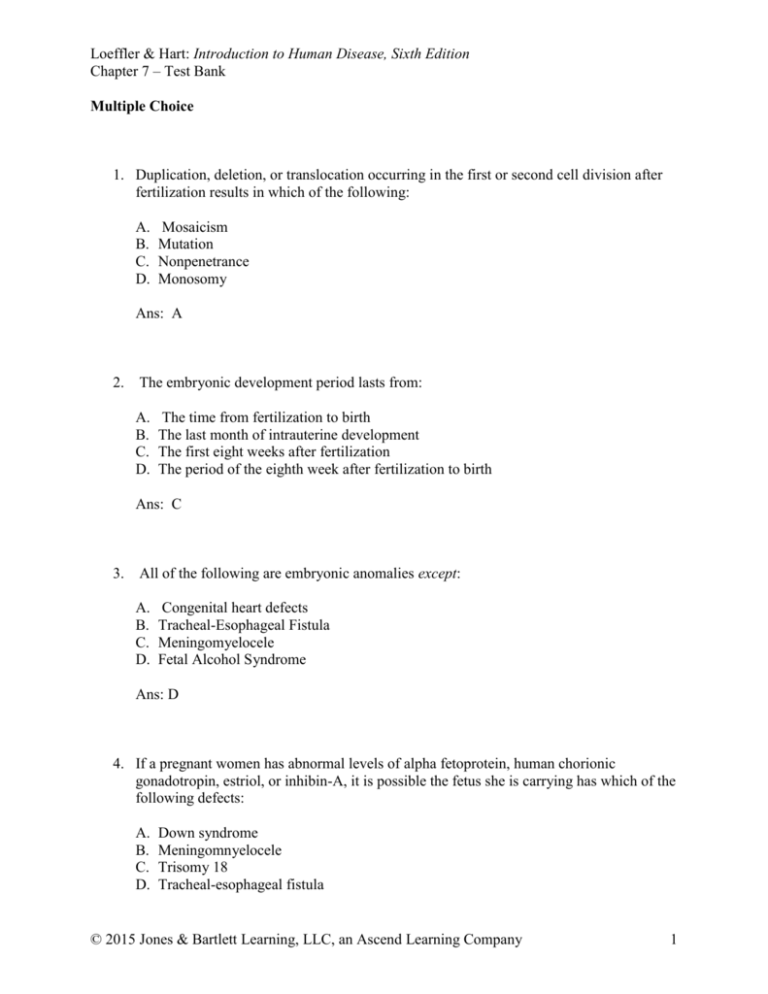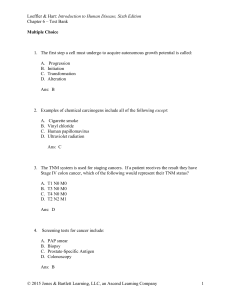chapter 7
advertisement

Loeffler & Hart: Introduction to Human Disease, Sixth Edition Chapter 7 – Test Bank Multiple Choice 1. Duplication, deletion, or translocation occurring in the first or second cell division after fertilization results in which of the following: A. B. C. D. Mosaicism Mutation Nonpenetrance Monosomy Ans: A 2. The embryonic development period lasts from: A. B. C. D. The time from fertilization to birth The last month of intrauterine development The first eight weeks after fertilization The period of the eighth week after fertilization to birth Ans: C 3. All of the following are embryonic anomalies except: A. B. C. D. Congenital heart defects Tracheal-Esophageal Fistula Meningomyelocele Fetal Alcohol Syndrome Ans: D 4. If a pregnant women has abnormal levels of alpha fetoprotein, human chorionic gonadotropin, estriol, or inhibin-A, it is possible the fetus she is carrying has which of the following defects: A. B. C. D. Down syndrome Meningomnyelocele Trisomy 18 Tracheal-esophageal fistula © 2015 Jones & Bartlett Learning, LLC, an Ascend Learning Company 1 Loeffler & Hart: Introduction to Human Disease, Sixth Edition Chapter 7 – Test Bank Ans: D 5. Variants of a single gene are called A. Mutations B. Mosaics C. Alleles D. Homozygotes E. Heterozygotes Ans: C 6. Nonpenetrance refers to A. Variable expressivity B. Lack of expression of a recessive allele because it is inhibited by a dominant one C. Inability of a sperm to fertilize an ovum D. Formation of a Barr body E. Lack of expression of a dominant allele Ans: E 7. Conditions caused by abnormal chromosomal copy number A. are called genetic diseases B. are caused by teratogens C. are familial D. usually affect more than one organ E. are the same as complex gene defects Ans: D 8. Which of the following statements about genetic diseases is true? A. They are always present in other family members B. They are always manifest at birth C. They are always due to abnormalities in a single gene © 2015 Jones & Bartlett Learning, LLC, an Ascend Learning Company 2 Loeffler & Hart: Introduction to Human Disease, Sixth Edition Chapter 7 – Test Bank D. Females never demonstrate X-linked disorders such as hemophilia E. They are always caused by altered nucleic acid sequences Ans: E 9. Which of the following agents is not a known teratogen? A. Alcohol B. Rubella virus C. Maternal iodine deficiency D. Thalidomide E. Folate Ans: E 10. Diseases of childhood and adolescence differ from those of infancy in that A. Accidents are more common in infancy B. Genetic and chromosomal diseases are usually not detected until childhood and adolescence C. The effects of congenital disorders, prematurity and an adverse intrauterine environment are more common causes of diseases in infancy D. Neoplastic disease is more common in infancy E. Children are more susceptible to infectious diseases because infants are protected by maternal antibodies Ans: C 11. Which of the following tests are not commonly done at birth to detect congenital diseases? A. Blood test for phenylketonuria B. Blood test for sickle cell anemia C. Physical examination D. Triple-screen test for Down syndrome E. Blood test for congenital hypothyroidism Ans: D © 2015 Jones & Bartlett Learning, LLC, an Ascend Learning Company 3 Loeffler & Hart: Introduction to Human Disease, Sixth Edition Chapter 7 – Test Bank True/False 12. An example of a sex-linked recessive disorder is cystic fibrosis. Ans: False 13. Abnormal genes causing recessive diseases can be transmitted through many generations before causing disease. Ans: True 14. An example of an autosomal dominant disease is Duchenne Muscular dystrophy. Ans: False © 2015 Jones & Bartlett Learning, LLC, an Ascend Learning Company 4








